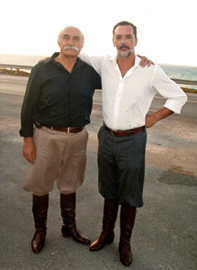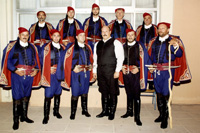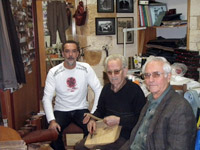
History
The Gilota is now an integral part of everyday and formal dressing of the Cretan men. It has largely replaced the Vrakes, which are worn today in formal occasions. In Western Crete, the gilota is combined with a waistcoat and a classic jacket made from the same cloth and footwear up to the knee. The Colors vary as well as the designs. It is used high-quality fabric, such as woolen, wool-cashmere, wool-silk, etc., as well as of English, Italian, Australian and Greek origin, through a rigorous selection with respect to the maintenance of local tradition. In order to bring a successful result, we take into consideration, the contribution of the traditional way as well as the fact that the gilota needs to be tailor-made, keeping up the exact measurements, according to the specific body type, and not in size standards or patterns etc. Also, the tradition requires and imposes a bodice garment, buttons and buttonholes on its entirety.
It is of great responsibility for the person who is wearing the attire and must ensure that it is always clean, ironed, while the gilota "falls nicely" to the right place, the shoes are polished and it generally honors the costume as it befits 'a Meraklis'.
"Τη κρητική τη φορεσιά όποιος τηνε φοράει, πρέπει να τηνε σέβεται και να τηνε τιμάει."
A significant financial comparison between Vrakes and Gilotes is the main reason that the first one is excluded while the Gilotes has enabled more and more younger crowd to dress traditionally.
All this would be history, if there were tailors who would not hand over our cultural heritage to the younger with the appropriate love and patience.
One of them is my teacher, Marentovangelis from Marediana in Kissamos , who taught me this traditional art of sewing for free. He was the last seamster who kept and maintained purely the line of local particularity, onto the male attire of Western Crete. With a great love and great respect to Disciple and follower of this wonderful local art, I pursue the original sewing operation on the handmade male attire. I’m a Great grandson of Ioannis G. Malinakis, who was kniting the black crochet(gampalia) attached to the boots(stivania) for the Vrakes, today, I keep learning on how to sewmake the Vrakes from my teacher Mrs. Dimitra Ktistaki-Karkani from Askyfou, Sfakia. . A modest man, humble, with great patience and love for traditional Cretan attire (male & female) and tradition, which were maintained over the centuries is willing to pass this art of our cultural heritage selflessly to anyone asking for it.
Telemachus Ksyrafakis from Palaia Roumata, 89 years now, he selflessly teaching me - with equally great patience and love- the art of traditional shoe making (stivania), which, as he remembers and insists must be "tall and upright." The quality of materials contributes for a perfect result. Calfskin leather is used with the same lining made out of calfskin or goatskin for better resistant and it is breathable.
According to the art stakeholders, nowadays, the younger crowd wants to experience the diversity of Cretan worldview in all aspects of daily life, Apparel-song-dance as an antidote to the global model that sell multinationals.
"ΘΑ ΠΟΛΕΜΩ ΩΣΤΕ ΝΑ ΖΙΩ ΣΤΟΝ ΕΔΙΚΟ ΜΟΥ ΤΟΠΟ,
ΣΥΜΦΩΝΑ ΜΕ ΤΑ ΕΘΙΜΑ ΤΩ ΠΑΛΑΙΩ ΑΝΘΡΩΠΩ."




